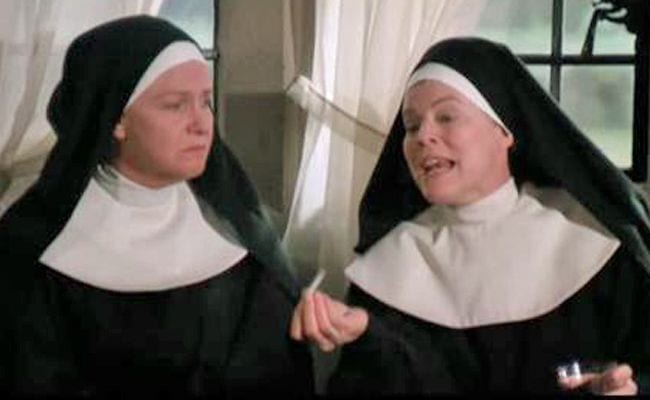
Nasty Habits transfers the details of the Watergate scandal into a Philadelphia convent, with Glenda Jackson playing the Nixon role of an icy abbess who secretly tapes everyone. As a satire of Watergate, it feels pointless and cumbersome; it might work better as a satire of the Church by implying that all hierarchies of power can use similar methods. The movie at first feels like such a takedown; it opens by showing the nuns drinking, smoking, swearing, and fornicating with Jesuits. Then, however, the screenplay throws in some exposition between a monsignor in Rome (Eli Wallach) and his “PR priest” (Jerry Stiller) in which they explain that this convent isn’t really an official part of the Catholic Church but some bizarre fabricated reactionary order that doesn’t recognize the reforms of the Second Vatican Council, and they may end up having to correct it or disown it. So there goes that interpretation.
They even explain that this Philadelphia order is an off-shoot from one in Crewe, England, because the film is based on Muriel Spark’s novel The Abbess of Crewe, but why bother? So much of the film induces this sense of “why bother”. Why bother to have two seminarians “break in” to the abbey to steal one troublesome nun’s love letters, which she keeps in an unlocked box in a public place, and have them come back the next day to be caught? Couldn’t any senior nun have taken the letters? Ah, but it’s all necessary to parallel Watergate. When your allegory takes precedence over common sense in your main story, you’re in trouble.
Another example: Melina Mercouri plays a Kissinger figure who’s abroad doing missionary work in various hotspots. At one point, she’s surrounded by penguins (a visual pun on nuns), although the abbess claims she’s at the North Pole with the Eskimos. After a brief appearance at the beginning, she spends the whole movie offering advice on the phone, none of which is funny or interesting. She’s serving a symbolic function only, the effect of which is that she sticks out like an undigested subplot.
The cast is overqualified. Sandy Dennis is the most amusing as a loud, gauche nun (apparently a take on John Dean), surrounded by Geraldine Page (basically Haldeman, according to IMDB, although she’s technically in the VP position of Spiro Agnew), Anne Meara (a clueless and accident-prone Gerald Ford), Anne Jackson, Susan Penhaligon, and Edith Evans (dying in the first scene, perhaps to her relief), with a wasted appearance from Rip Torn.
We’re supposed to laugh in recognition when the abbess quotes Nixonisms like “But that would be wrong” and “You won’t have [me] to kick around any more”, just as we’re supposed to laugh at that old standby, anyone doing anything while dressed in a nun’s garb. The results are clumsy, mainly in script and editing. Director Michael Lindsay-Hogg, who’s had a fascinating career, went on to better things, including another nun project in the theatre (Agnes of God ) and co-directing the TV serial Brideshead Revisited.


![Call for Papers: All Things Reconsidered [MUSIC] May-August 2024](https://www.popmatters.com/wp-content/uploads/2024/04/all-things-reconsidered-call-music-may-2024-720x380.jpg)



